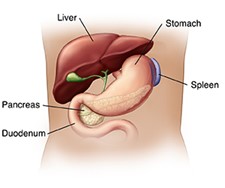
November is Pancreatic Cancer Awareness Month. According to the American Cancer Society, pancreatic cancer accounts for about 3% of all cancers in the United States and about 7% of all cancer-related deaths. Here’s an overview of the symptoms, risks, and more about pancreatic cancer.

What is the pancreas?
To start, let’s take a closer look at what the pancreas is and what it does. The pancreas is a large gland that is part of the digestive system. It is located inside the belly (abdomen) just behind the stomach and is about the size of your hand. The pancreas makes two important things:
- Enzymes that aid in food digestion by breaking down sugars, fats, proteins, and starches, so your body can better absorb nutrients from food.
- Hormones to help regulate your blood sugar levels (glucose) and appetite, stimulate stomach acids, and tell your stomach when to empty. Learn more about the pancreas’ role in digestion and the different pancreatic enzymes and hormones.
The pancreas is made up of two main types of cells:
- Exocrine cells: Responsible for making digestive juices that help break down food.
- Endocrine cells: Release hormones, like insulin, into the bloodstream to manage essential body functions.
What is pancreatic cancer?
There are two main types of cancer that can start in the pancreas: adenocarcinomas and pancreatic neuroendocrine tumors (PNETs). Adenocarcinomas start in the exocrine cells of the pancreas. PNETs start in the endocrine cells. Learn more about pancreatic cells and types of pancreatic cancer.
Risk factors:
Talk with your provider about your risk factors and what you can do to manage them. Risk factors for pancreatic cancer include:
- Older age
- Being a man
- Being African American or Ashkenazi Jewish descent
- Tobacco use
- Heavy alcohol use
- Obesity
- Type 2 diabetes
- A high-fat diet
- Chronic pancreatitis (long-term inflammation of the pancreas)
- Family history of pancreatic cancer
- Certain inherited genetic syndromes, such as Lynch syndrome, MEN1, hereditary breast and ovarian cancer syndrome, and hereditary pancreatitis
- H. pylori infection
- Hepatitis B infection
Prevention:
There is no sure way to prevent pancreatic cancer, but you can help lower your risk by making lifestyle changes including:
- Eat a balanced diet
- Be physically active
- Stay at a healthy weight
- Don’t smoke
- Don’t drink alcohol or drink only in moderation
Screening:
There are no screening tests for people at average risk for pancreatic cancer. If you have a strong family history of the disease, consider talking with your provider about possible screening. Screening may include CT or MRI scans to look for tumors in the pancreas or genetic counseling and testing to find out if you are at increased risk.
Symptoms of pancreatic cancer include:
- Yellowing of your eyes or skin (jaundice)
- Itchy skin
- Dark yellow or brown urine
- Pale, greasy, foul-smelling stools that may float in the toilet
- Pain in your stomach or back
- Indigestion or discomfort after eating fatty foods
- Loss of appetite
- Unexplained weight loss
- Nausea and vomiting
- Extreme tiredness
- Blood clots in your leg. This can cause pain, redness, or swelling in the leg.
- Blood clots in your lung. This can cause shortness of breath or chest pain.
- Uneven, lumpy fatty tissues under your skin.
These symptoms can be caused by other health problems. If you are experiencing any of these symptoms, please make an appointment right away with your primary care provider or gastroenterologist.
Diagnosis:
If your provider suspects you may have pancreatic cancer, you’ll need tests and exams to be sure. Tests may include blood tests, imaging and endoscopy tests, or a pancreatic biopsy. Read more about possible tests for pancreatic cancer diagnosis.
Treatment:
There are several treatments options for pancreatic cancer, including surgery, radiation therapy, chemotherapy, targeted therapy, and immunotherapy. Talking with your provider about the available treatments, their potential success, and the associated risks and side effects can help you decide which option is best for you. Read more about pancreatic cancer treatment choices.
Learn more about digestive care at Valley.
Learn more about cancer care at Valley.
In need of a primary care provider? Find one near home or work.
This article was reviewed by Joseph Roberts, MD, with Valley’s Gastroenterology Clinic. Content for this article is derived from the Staywell Health Library. Content in this article is for educational purposes only and is not a substitute for professional medical advice.
Digestive system graphic courtesy of the Staywell Health Library.


I would like to start seeing a urologist with emphasis on Pancreatic screening. I have symptom issues related to the pancreas…reduced flow and enlarged pancreas. We just moved back to the NW from California and I had regular check ups by the Urology Clinic at Loma Linda but it has been over a year since the last check up.
Hi Clayton,
Thank you for reading our blog. Please call the Urology Clinic at 425.690.3493. They can advise you if you will need to have a referral from your primary care provider or if you can do a records request from your previous urologist to schedule an appointment.